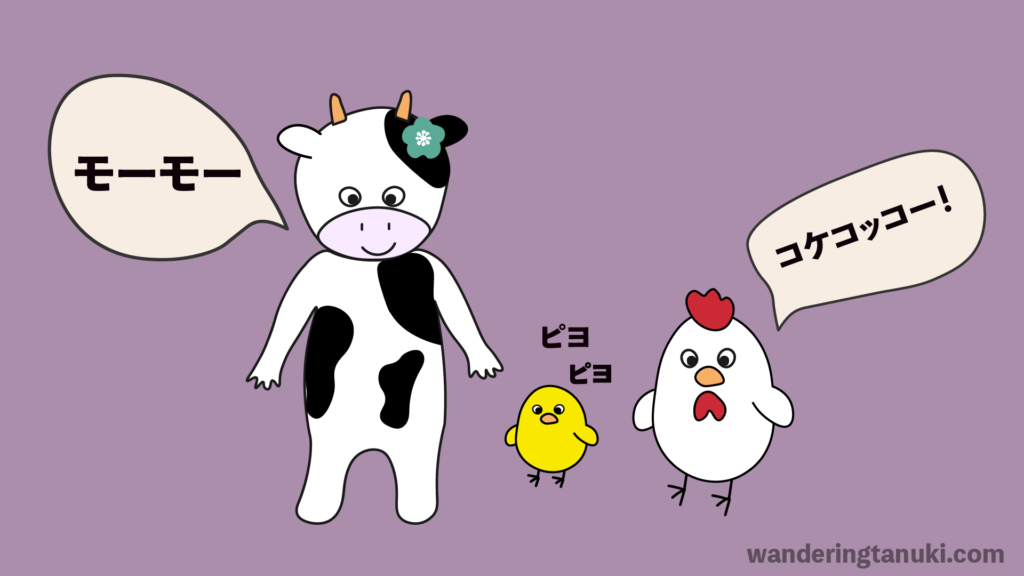24 Japanese Animal Sounds or Onomatopoeia!
Ever wondered what a dog’s bark is in Japanese? It’s not “woof woof” but “wan wan”. There are a whole set of words that represent animal sounds or onomatopoeia in Japanese. Because these sounds are usually tied to common animals in Japan, you might notice some unique animals such as cicadas and foxes in this list.

As you learn the animal sounds in Japanese, I recommend that you first listen to the audio. Then, try and guess what animal it could be. See if any of them surprise you!
Note: scroll to the end if you want to know how to use these Japanese animal sounds or onomatopoeia with verbs.
1. ワンワン (wan wan)
In Japanese, the most generic dog sound is “wan wan”. It’s like the English “woof woof”.
Example:
犬がワンワン吠える。
Inu ga wan wan hoeru.
The dog went “woof woof”.
2. キャンキャン (kyan kyan)
This describes dog sounds that are from a smaller dog like a chihuahua. It can also represent a small dog that is in distress.
Example:
犬がキャンキャン鳴いて逃げていく。
Inu ga kyan kyan naite nigete iku.
“Yap yap!” The dog ran away.
3. ニャーニャー (nyaa nyaa)
A cat’s “meow” is represented by “nyaa nyaa” in Japanese. A cat can sometimes even be called a ニャンコ (nyanko).
Example:
子猫がニャーニャー鳴いている。
Koneko ga nyaa nyaa naite iru.
The kitten went “meow meow”.
4. ゴロゴロ (goro goro)
The purr sound of a cat is “goro goro”.
Example:
猫がゴロゴロ喉を鳴らして近づいてくる。
Neko ga goro goro nodo o narashite chikazuite kuru.
The cat came closer while purring.
5. ブーブー (buu buu)
This is the equivalent of “oink oink” in English and represents a pig’s sound.
Example:
豚がブーブー鳴きながらご飯を食べている。
Buta ga buu buu nakinagara gohan o tabete iru.
The pig went “oink oink” as they ate their food.
6. モー (moo)
Moo is a cow sound that looks similar to English. However, it’s important to remember that the pronunciation is different.
Example:
牛がモーと鳴いて寄ってくる。
Ushi ga moo to naite yotte kuru.
The cow said “moo” as it came closer.
7. コンコン (kon kon)
One of the most unique Japanese animal sounds or onomatopoeia is “kon kon” for a fox sound. This is because a translation doesn’t really exist in English. The foxes are a common and important animal in Japan.
Example:
狐がコンコン鳴いている。
Kitsune ga kon kon naiteiru.
The fox went “kon kon” (no translation in English for fox sounds).
8. メェーメェー (mee mee)
This one applies to both goats and sheep and it’s like “baaa” in English.
Example:
子山羊がメェーメェー鳴いている。
Koyagi ga mee mee naiteiru.
The baby goat went “baaa”.
9. ピヨピヨ (piyo piyo)
A baby chick makes the sound “piyo piyo” in Japanese.
Example:
ひよこがピヨピヨ鳴きながら遊んでいる。
Hiyoko ga piyo piyo nakinagara asondeiru.
The baby chick went “chirp chirp” as they play.
10. コケコッコー (koke kokkoo)
A rooster’s sound is “koke kokkoo”. It sounds a bit like “cockadoodledoo”.
Example:
朝から鶏がコケコッコーと鳴いた。
Asakara niwatori ga kokekokkoo to naita.
The rooster went “cockadoodledoo” in the morning.
11. ケロケロ (kero kero)
Frogs make the sound “kero kero”. If you know the frog sanrio character, kerokero keroppi, you’ll recognize that this onomatopoeia was used in his name.
Example:
カエルがケロケロ鳴いている。
Kaeru ga kerokero naiteiru.
The frog goes “ribbet ribbet”.
12. ゲロゲロ (gero gero)
For larger frogs or toads you can use “gero gero”. It sounds a bit lower in pitch.
Example:
ガマガエルがゲロゲロ鳴いている。
Gamagaeru ga gero gero naiteiru.
The toad goes “croak croak”.
13. パオーン (paoon)
Elephants can sometimes make trumpet-like sounds from their trunks. In Japan people think it sounds like “paoon”.
Example:
動物園でゾウがパオーンと鳴いていた。
Doubutsuen de zou ga paoon to naiteita.
The elephant at the zoo went “paoon” (I don’t think there is an English equivalent”.)
14. ポッポ (poppo)
The pigeon’s sound is “poppo” in Japanese.
Example:
屋根の上で鳩がぽっぽ鳴いている。
Yane no ue de hato ga poppo naiteiru.
The pigeons on the roof go “coo”.
15. ガオー (gaoo)
This is the word for “roar” in Japanese. It can apply to any animal that growls like lions, tigers, etc…
Example:
ライオンがガオーと襲いかかった。
Raion ga gaoo to osoikakatta.
The lion went “roar” and attacked.
16. チューチュー (chuu chuu)
The sound for a mouse is “chuu chuu”, which is like “squeak squeak” in English.
Example:
天井でネズミがチューチュー鳴いていた。
Tenjou de nezumi ga chuu chuu naiteita.
The mouse went “squeak squeak“ in the ceiling.
17. カーカー (kaa kaa)
There are a lot of crows in Japan and a crow’s sound is “kaa kaa” in Japanese.
Example:
カラスがカーカー鳴いていた。
Karasu ga kaa kaa naiteita.
The crow went “caw caw”.
18. ガーガー (gaa gaa)
This is the sound of ducks in Japanese. I personally think it’s closer to the actual sound of a duck than “quack quack”.
Example:
アヒルがガーガー鳴いて泳いでいる。
Ahiru ga gaa gaa naite oyoideiru.
The duck goes “quack quack” while swimming.
19. ヒヒーン (hihiin)
This sound represents a horse’s neigh.
Example:
馬がヒヒーンといななく。
Uma ga hihiin to inanaku.
The horse went “neigh”.
20. ホーホー (hoo hoo)
An owl sound is “hoo hoo” and it’s similar to how we represent it English as “hoot hoot”.
Example:
夜、梟がホーホーと鳴いていた。
Yoru, fukurou ga hoo hoo to naiteita.
At night the owl went “hoot hoot”.
21. ミーンミーン (miin miin)
This is a characteristic sound of a Japanese summer and represents the sound of cicadas.
Example:
夏、セミがミーンミーンと鳴いていた。
Natsu, semi ga miin miin to naiteita.
During the summer, the cicadas went “miin miin”. (no translation of this sound in English)
22. リンリン (rin rin)
“Rin rin” represents the sound of bell crickets. They are a special bug that some people keep as pets in Japan because of their sounds.
Example:
鈴虫がリンリン鳴いていた。
Suzumushi ga rin rin naiteita.
The bell cricket went “chirp chirp”.
23. チンチロリン (chin chirorin)
This is the sound of a pine cricket. It makes a very specific sound and is distinct from other bugs.
Example:
松虫がチンチロリンと鳴いていた。
Matsumushi ga chinchirorin to naiteita.
The pine cricket went “chirp chirp”.
24. コロコロ (koro koro)
The sound of a regular cricket is represented by “koro koro”.
Example:
夜、コオロギがコロコロ鳴いていた。
Yoru, koorogi ga korokoro naiteita.
At night, the crickets went “chirp chirp”.
How to use Japanese animal sounds or onomatopoeia:
Using these animal sounds or onomatopoeia are relatively simple. You’ll usually find them before a verb. The most common verb is 鳴く(naku) or to cry. It can be applied to most animal sounds.
For example:
猫がニャーニャー鳴く。
Neko ga nyaa nyaa naku.
The cat goes “meow meow”.
Sometimes you’ll find that a と is added before the verb. Some animal sounds/onomatopoeia tends to sound more natural when this is added. However, there’s no specific rule to this. You’ll just have to see how native speakers use it.
For example:
猫がニャーニャーと鳴く。
Neko ga nyaa nyaa naku.
The cat goes “meow meow”.
Special verbs and circumstances:
If you are talking about a dog or horse, you can also use these verbs instead of 鳴く (naku).
吠える (hoeru) – to bark
いななく (inanaku) – to neigh
In addition, in some cases you can attach action verbs that show the action. For example, with ガオー (gaoo) you can say ライオンがガオーと襲いかかった。This would mean “the lion roared while attacking”.
I hope this article helped you learn all about animal sounds or onomatopoeia in Japanese! If you want to know more about Japanese onomatopoeia, be sure to check out Manga Onomatopoeia: Sound Effects! If you enjoy other Japanese language learning blog content here are some more articles: Wasei-eigo!: 25 Fake English words in Japanese or 10 Japanese Trending Slang Phrases of 2021
~ Tanuki





